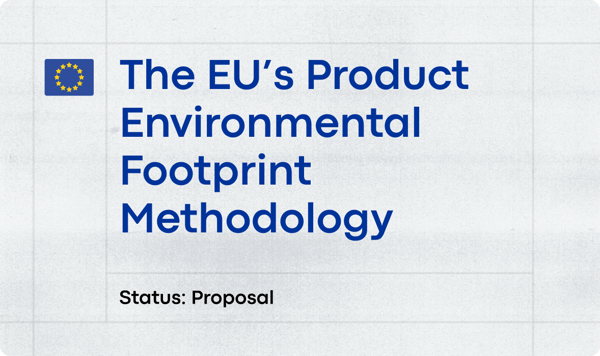When it comes to corporate climate action, companies need to measure and reduce carbon emissions throughout their value chain... It's a workflow Allbirds knows well. The company was founded in 2016 with a single shoe—the now iconic Wool Runner— and a commitment to make better things in a better way. That commitment includes a laser-focus on carbon reduction, a focus that motivated Allbirds to become the first fashion brand to label its products with their carbon footprint in 2020. Shortly thereafter, Allbirds open-sourced their carbon calculator for use by the entire industry.
In the years since, standards and legislation have continued to evolve, underscoring an even greater need for technology to support emissions measurement at scale. Now nearly five years after introducing their carbon labels and calculator, Allbirds is evolving its carbon reduction strategy to include Carbonfact.
We sat down with Aileen Lerch, the Director of Sustainability at Allbirds, to discuss why she chose Carbonfact to power the company’s decarbonization journey.
Allbirds' sustainability journey
Carbonfact: Aileen, could you introduce yourself and share the inspiration behind Allbirds' sustainability journey?
Aileen: Hello! I lead sustainability at Allbirds, which is a San Francisco-based B Corp that makes footwear with premium natural materials. Since 2020, Allbirds has labeled all of our products with their carbon footprint. There are two main reasons for this:
1) We wanted to help people understand the impact of the products that they're buying. It’s a lot like understanding the calorie count on a food nutrition label. It's a meaningful metric that consumers can use as they adopt more sustainable buying behaviors.
2) Labeling each product with its carbon footprint is a great accountability measure for us as a brand. When you put your carbon footprint out there in the world, it means you have to commit to bringing it down and then seeing what you can achieve year after year.
In 2021, we developed our sustainability strategy, called the Flight Plan, after extensive stakeholder engagement with employees, leadership, suppliers, customers, and the community. While sustainability encompasses a swath of issues like biodiversity, water quality, animal welfare, and human rights, we focused our efforts on climate change to achieve the greatest impact.

Allbirds' targets and concrete initiatives
Carbonfact: Looking towards Allbirds' sustainability goals for 2024 and beyond, what key initiatives are you focusing on to achieve these ambitious targets?
Aileen: When we started making our strategy, something we noticed was that a lot of companies set far-off, ambitious targets for decarbonization. But they really didn’t know how they were going to get there. Allbirds took a different approach. We first identified three strategic pillars: regenerative agriculture, renewable materials, and responsible energy, to decarbonize our business.

Then we set specific initiatives within each pillar that directly result in reducing carbon emissions. For example, by 2025, we aim to achieve targets like reducing the use of raw materials by 25% and achieving a steady state of at least 95% ocean shipping.

By modeling these initiatives in a detailed way, we were able to set very ambitious—but realistic—near-term targets to reduce our average carbon footprint in half by 2025 and bring it towards near zero in 2030.
Thanks to Carbonfact, we are evolving the detailed modeling of our product carbon footprints and business emissions. This allows us to continue to predict the impact of specific initiatives, which ensures a clear and actionable path towards achieving our climate objectives.

Before Carbonfact: Excel-based LCA tool
Carbonfact: Before working with Carbonfact, you actually created an Excel-based LCA (Life Cycle Assessment) tool for your carbon footprint modeling, which you then open-sourced with the industry. Why did you decide to upgrade?
Aileen: The Excel LCA tool enabled us to share our carbon footprint numbers with the world, hoping that others would follow and adopt standardized methodologies for comparison. We had the tool third-party verified, and as you said, we open-sourced it to encourage other brands to join us in the effort.
In 2022, we soon began to realize that there were a host of internal and external changes coming and we would have to adapt. On our side, the breadth of data we were collecting was becoming really challenging to manage. Imagine numerous spreadsheets each with numerous tabs open—things like a bill of materials—to track our decarbonization efforts. Manipulating the data was tedious. For example, we’d have to manually adjust the blend of a material. It was really challenging to do dynamic modeling. It just wasn’t very efficient.
Combine this with external factors–like increasing legislation on environmental claims and reporting, and the proliferation of new tools to support these processes–and it was clear that we needed to stay nimble to align with evolving best practices. The Excel LCA tool took us a long way, but we needed a platform that could manage all this data, create meaning from it, and help us conduct better modeling.
Once we decided to upgrade, I spent almost two years researching different software options before landing on Carbonfact at the end of 2023.

Allbird's key challenges
Carbonfact: Can you elaborate on some of those key challenges that you wanted to address?
Aileen: The first challenge was trying to consolidate all of the data. Data was scattered across different systems and internal teams. It was a lot of manual work for me, especially when I needed to dedicate my time to identifying decarbonization initiatives. Plus, as I’ve mentioned, the data was static and quickly outdated.
Secondly, gathering product data in the first place was really burdensome. Emissions factors are complex. There are a lot of different datasets out there and it’s tough to stay up to date with everything. I was looking for a software provider that I could trust to accurately source, show, and model these different emissions factors.
The next challenge is related to that. There is an evolving legislative landscape for brands around the world. And again, that’s a full-time job just keeping up with new regulations. I needed to find a software solution—a partner—that could help manage and stay abreast of all of the reporting changes.
And finally, Allbirds didn’t want to simply do a broad decarbonization forecast. We needed a tool that could provide specific and detailed scenarios happening at the material, component, or style level.
Why Carbonfact
Carbonfact: Upgrading to a new software sounds like a pivotal moment for Allbirds. What led you to choose Carbonfact as your partner in this journey?
Aileen: When I first connected with Carbonfact, I was really excited by how closely aligned our two businesses were. Everything I was asking for, Carbonfact was already thinking about. In a nutshell, we chose Carbonfact because of its product-level focus, scalability, and advanced reduction modeling capabilities, which were crucial for our sustainability objectives.
As I mentioned earlier, our previous LCA tool was extremely labor-intensive. Carbonfact allowed us to reduce that manual work and transition all calculations to the platform. Additionally, Carbonfact's uncertainty metric helps us prioritize data collection by identifying hotspots with the highest impact.
Another feature that’s been really transformative for us is the Impact Simulation tool. With this, we can calculate the carbon footprint of the product before it’s even produced. That allows us to be proactive in our carbon management and choose the best, most sustainable strategy.
Product simulations: Recycled nylon instead of virgin
Carbonfact: Can you share a concrete example of one or two simulations that you ran with the product modeling tool and any concrete changes you’ve made (or plan to make) based on that?
Aileen: Sure, so as I mentioned, Carbonfact’s Product Impact Simulation tool is a crucial feature to Allbirds. It can help us analyze various scenarios and make informed decisions aligned with our sustainability goals. For example, Allbirds wanted to start using recycled nylon instead of virgin, as a lower carbon alternative. In order to make this decision in alignment with internal stakeholders, like our materials team, we need to demonstrate the cumulative impact of carbon reduction that would result across the entire business. This is a perfect example of where Carbonfact’s Product Impact Simulation tool can be of use.
Impact simulation extends beyond the product level. We can simulate the impact of switching our retail locations to renewable energy or using ocean shipping instead of air. It’s huge for us. We’ve incorporated impact simulation into the entire process of creating products, or thinking about initiatives for the year ahead and identifying what changes we can make.
Carbonfact: Allbirds has been a pioneer in open-sourcing sustainability solutions like the carbon footprint calculator. How does your collaboration with Carbonfact influence this openness?
Aileen: We’ve always strived to balance scalable, accurate information with transparency and clear methodology. Annually, we verify our full greenhouse gas inventory to maintain high standards of accuracy. What I appreciate about our partnership with Carbonfact is your focus on data accuracy and transparency. The platform highlights data accuracy, showing where primary data is used and where gaps exist, which ensures we provide the best information possible.
Carbonfact: In what ways do you think this partnership between Allbirds and Carbonfact can inspire the broader industry?
Aileen: Ultimately, LCA and carbon management tools need to be common in the industry and shared. At Allbirds, we have experienced this journey of developing a bespoke LCA tool before eventually migrating to Carbonfact where our data was easier to track, understand, and forecast. I think industries will benefit from a shift away from bespoke, in-house tools and toward platforms—like Carbonfact—that are available to everyone and can be used in a very systematic way.
You know, the industry as a whole is grappling with verification, transparency, and getting this information out to the public. It’s urgent and it’s critical. So, with Carbonfact, I think we’re able to move forward in a scalable way.
Carbonfact: Last but not least, what advice do you have for other apparel and footwear brands when selecting a carbon management platform?
Aileen: I hear a lot of companies say, “we can't start modeling or forecasting because we actually don't even have any data about our products or our supply chain.” But you have to start somewhere, and working with a sustainability platform can get you started on that journey.
So, I would say: start by understanding your specific needs and challenges… even if that challenge is not having all the data! Then, look for a software solution that offers robust modeling capabilities. It can be tempting to look at solutions that offer big-picture calculations, but that might not serve your company when you need detailed actionable insights into your data. It’s helpful to choose software that aligns with your industry’s specific requirements.
Decarbonization planning with Allbirds
Carbonfact recently hosted a webinar with Aileen Lerch and our co-founder Martin Daniel. You can view it here to see our software in action as we do a live demo addressing some of Allbirds’ greatest challenges. To learn more about how Carbonfact can help your brand develop detailed life-cycle assessments and sustainability modeling, book a demo call with our team.







 Lidia Lüttin
Lidia Lüttin

![[Guide] Carbon accounting for fashion, textile, apparel, and footwear companies](https://www.carbonfact.com/hs-fs/hubfs/CA%20-%20Opt1.png?width=600&name=CA%20-%20Opt1.png)
 Angie Wu
Angie Wu